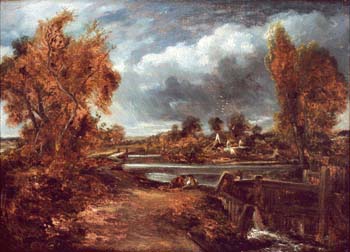Study for Landscape: Boys Fishing
- Related to 1813 painting
- John Constable (English/British 1776-1837)
[M. Robinson] - Oil on canvas
44.7 x 63.6 cm., 17-5/8 x 25-1/16"
- Lent Courtesy of Private Collection in Honor of Dr. Gary James Goebel through Catherine Carter Goebel, Paul A. Anderson Chair in the Arts

Essay by C. Kevin Geedey, Professor of Biology
Though he was not a formal student of science, the English landscape painter John Constable (1776-1837) took justifiable pride in his painstaking and careful observations of nature (Bailey 2007). He spent countless hours in the field, using tube oil paints so that he could paint while there, rather than from sketches in his studio. He is known for accurate details, like the bend of his trees matching the direction of prevailing winds, and nowhere is this understanding of nature clearer than in his treatment of clouds. Constable also adopted the new scientific vocabulary (e.g., cumulus, cirrus ) to describe clouds. He often went skying (sky watching) and resisted the advice of patrons to replace his sometimes dark skies with clear blue backdrops.
Constable's philosophy is well-expressed in lectures he gave a few years before his death for the Royal Institution, an important promoter of science. Audiences flocked to R. I. lectures to hear new ideas, and to also see flamboyant chemistry demonstrations by the likes of Humphrey Davy and Michael Faraday (the latter of whom attended Constable's talks). Although Constable was clearly Romantic in his perspective (he wrote that "painting is feeling"), he also argued that a painting could be like a scientific experiment. The dominant philosophy of science in his day, inductivism, stressed the need for thorough observations of nature and the avoidance of speculation until theories presented themselves from the amassed facts (Bowler 1989). Likewise, Constable believed that direct observation of nature, rather than the mere imitation of past masters, was the key to good landscape painting.
Although Constable sometimes painted seascapes, he loved inland waters best and many of his paintings feature the interactions of humans, both at work and play, with rivers. Through most of his career, Constable struggled with his relative lack of recognition in England. However, his paintings of the rural landscapes of his boyhood homeland in the Stour Valley eventually won him a seat in the prestigious Royal Academy. The region he painted is still often referred to as "Constable's Country."
